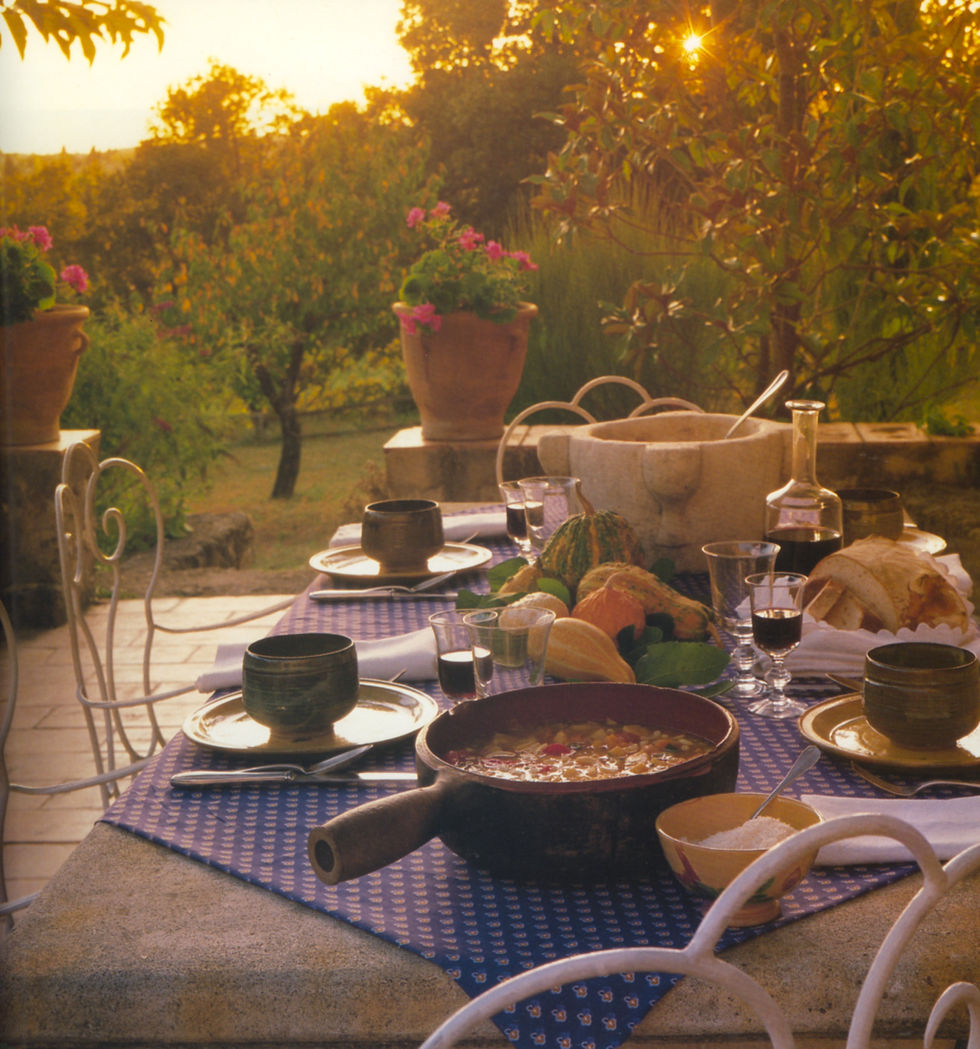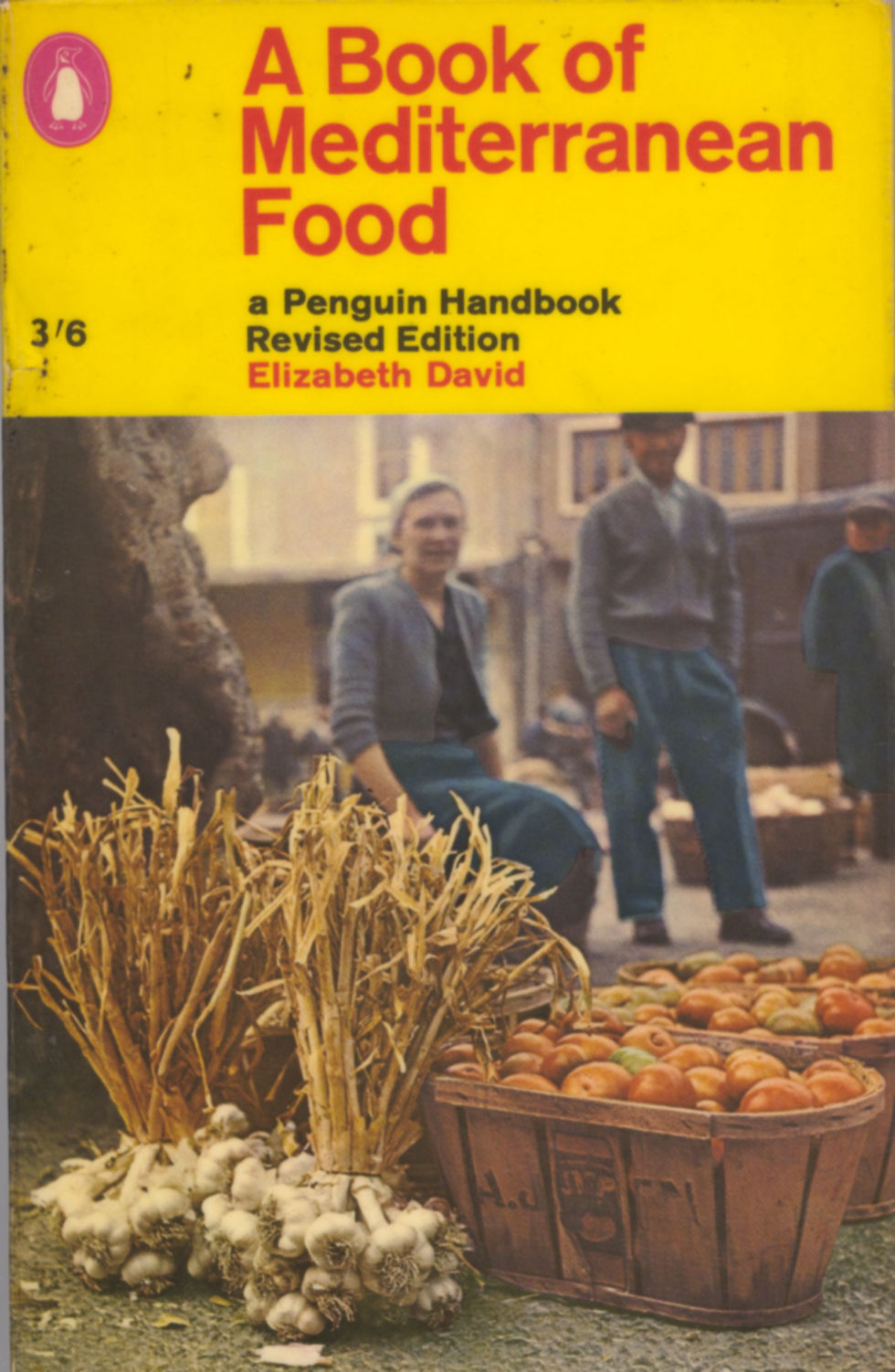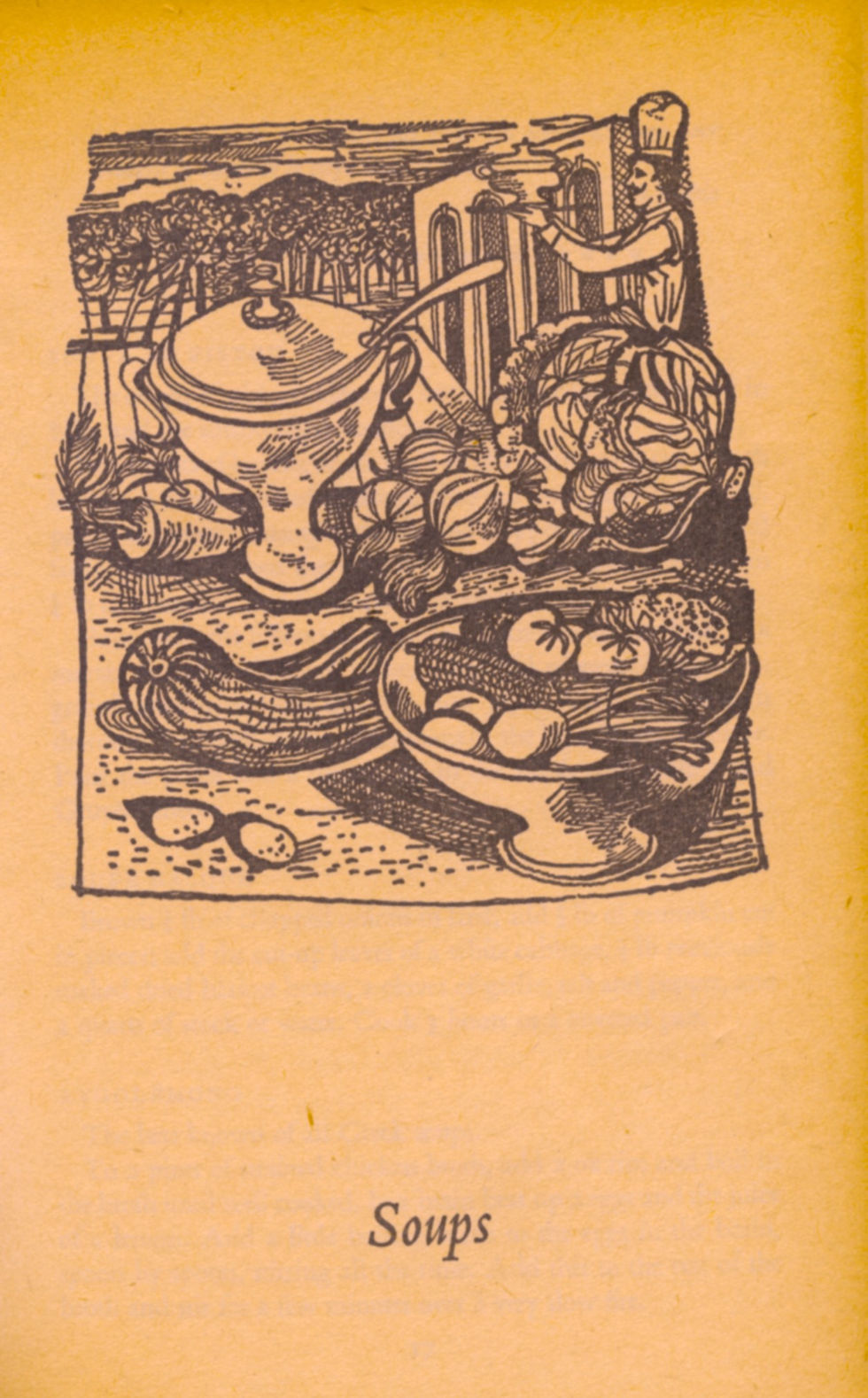Dreaming of the Mediterranean - a first recipe - soupe au pistou
- rosemary
- Feb 6, 2021
- 6 min read

"one of the finest soups known to man." Waverley Root
By Mediterranean I probably mean the south of France, but nevertheless this first recipe comes from the aptly named A book of Mediterranean food by Elizabeth David.
It was her first book, first published in 1950 and it is a small one. It is also the book that is credited for dragging Britain out of post-war dreariness into the sunshine of the Mediterranean. A move to olive oil, lemons, garlic and tomatoes - all but the tomatoes and perhaps the lemons, being really rather foreign to the British. This is long before cheap package holidays to the continent and beyond. It is a time when rationing was still in existence and when most of the ingredients we now take for granted were unknown and undreamt of.
"But even if people could not very often make the dishes here described, it was stimulating to think about them; to escape from the deadly boredom of queuing and the frustration of buying the weekly rations; to read about real food cooked with wine and olive oil, eggs and butter and cream, and dishes richly flavoured with onions, garlic, herbs and brightly coloured southern vegetables." Elizabeth David
Her aim was:
"I hope to ... stir the memories of those who have eaten this food on its native shores, and who would like sometimes to bring a flavour of those blessed lands of sun and sea and olive trees into their English kitchens."

And that is just what she has done for me today - stirred memories of the warm Southern French sun, the smell of pines and the singing of the cicadas. Hours spent ambling through picturesque villages, chatting with old friends around a table laden with food garnered from the boulangerie, the patisserie, the charcuterie and the market - even just the hypermarket, which didn't exist in Elizabeth David's day, or just sitting quietly in some ancient spot watching the world go by.
My edition of this seminal book is the revised Penguin edition which was published in 1965. I probably bought it later in the 60s. I see it has a price of 3/6 on it, so obviously I bought it in England. Australia had moved to dollars by the time we emigrated.
This particular book is not just French though. It is Mediterranean food and there are lots of dishes from elsewhere, although I think her love of France predominates. I have made so many dishes from this book in my time, and just browsing through it today has reminded me of some of them - Stiphádo, where I first discovered that you could use allspice in meat cookery, cassoulet, paêlla ... It was very probably my first venture into Mediterranean food that wasn't French.
It is also a book whose recipes are often more conversational than specific and always you come across her sometimes wry, sometimes dictatorial and sometimes slightly snooty style. So very Elizabeth David.
"I have devoted a special chapter ... to cold food, fine dishes which are particularly suitable to our servantless lives; prepared in advance and either preceded or followed by a spicy, aromatic southern dish, what more could one want?"

It's also, like all of her books in their original form, bereft of gorgeous photographs of the finished dishes. She leaves that to your imagination - an imagination that has been stimulated by her descriptions of places, of food, of people. There are however, line drawings at the front of each chapter by John Minton. This is the first chapter - Soups - not that unusual for a first chapter I suppose, although perhaps more often we have starters. Anyway - look at that beautiful soup tureen. There is a rather more rustic one in the photograph at the top of the page, which is taken from my Provence the Beautiful Cookbook. Why don't we serve soup like this any more? Is it because people like to decorate the soup with swirls of this, or sprinkles of that? Is the focus on the appearance these days rather than the taste? Alex Jackson - a modern English chef, warns that it is difficult to make soupe au pistou look great but that this should not matter:

"Soupe au Pistou, a murky green broth with soft, slowly cooked courgettes, sweet alliums and haricot beans, tiny pieces of pasta and a trail of bright green basil pistou across the top. It is breathtakingly good." Alex Jackson
Serving it in one of those sort of frilly looking French soup plates might help - as shown here.
So what is soupe au pistou? Well it's a bean soup with pesto. Or rather a French version of pesto. And it's the pesto that matters.
"The Niçoise have borrowed this sauce from their neighbours, adapted it to suit their own tastes, and called it, in the local dialect, pistou. It is the addition of this sauce to the soup which gives it it's name and its individuality. Without it, the soup would simply be a variation of minestrone." Elizabeth David

Indeed Felicity Cloake, who has, of course had a go at making the perfect soupe au pistou ends up with a version that doesn't seem to have many beans - well not green ones, in it at all, and suggests using all sorts of other vegetables. She also doesn't seem to have any pasta.
So how does pistou differ from pesto? Well - no pine nuts for starters, although I have seen versions that include them. Elizabeth David herself has two versions, in the one from this book it is simply basil, garlic and a grilled tomato pounded together. No olive oil. In the version in French Provincial Cooking, there is no tomato but there is olive oil. Richard Olney adds parmesan like the Italians but ignores the pine nuts too. There are also arguments about whether the pistou should be stirred into the soup or dolloped on top. The majority opinion seems to be a dollop on top, with Richard Olney going further and saying:
"Many cooks find it easier to mix the pistou into the soup before serving it at table, but the beauty of a handsome mortar in the centre of the table and the pleasure of seasoning one's soup to taste are then lost. If the guests season their soup to taste, twice as much pistou will be required than for a soup seasoned in the kitchen."
The photograph at the top of the page is from his Provence the Beautiful Cookbook and shows a table laid in Lourmarin in the Luberon including one of the most enormous mortars I have ever seen. Such a beautiful and nostalgic photograph.
Olney is also a little bit more enlightening about what should go into the soup itself:
"a century ago the soup itself was comprised of only potatoes, beans, tomatoes and pasta. It contained practically no liquid, and recipes warned the reader of the danger of its sticking and burning."
He has added squash, leeks, onions, carrots, and zucchini in his recipe. Personally I think I partially agree with Felicity Cloake in that it doesn't really matter what vegetables go into it, but I do think the emphasis should be on a mix of green and haricot beans, and there should be potato, tomato and probably zucchini in there too. And don't forget the pasta - something small. But even Elizabeth David, thought of as something of a purist, admits that recipes evolve over time:
"In the lands bordering the Mediterranean, as indeed almost everywhere else, the cooking is constantly evolving; traditional dishes are being adapted to modern techniques and to new ingredients, or to old ones which, as a result of modern methods of cultivation, transport, preservation, and storage, have undergone material modifications or even a basic change."

Quinoa anyone?
Jamie Oliver is modern and he has a version that he simply calls Pistou soup and it's pretty faithful to the spirit of Elizabeth David, although of course, these days we can use tinned beans but there are no pine nuts in his pistou, and look he dollops it on top. These days perhaps they are better at making it look good too.
So here is Elizabeth David's recipe - it's not very long. The recipe in French Provincial Cooking is not actually hers but comes from a 1926 cookbook. And it's a tiny bit more complicated. This one is very simple. Give it a try next time you have a lot of beans that you don't know what to do with. Sorry about the imperial measurements. Couldn't be bothered converting them I'm afraid. Besides it's not the kind of recipe where the portions need to be exact. Notice she calls the soup the 'pistou' when really it's the sauce you put on top which is the 'pistou'.
"Into 3 pints of boiling water put 1lb of French beans cut in inch lengths. 4 medium-sized potatoes, chopped finely, and 3 chopped, peeled tomatoes. Season with salt and pepper and let them boil fairly quickly. When the vegetables are almost cooked, throw in 1/4lb vermicelli and finish cooking gently.
Have ready the following preparation, known as an 'aillade'. In a mortar pound 3 cloves of garlic, a handful of sweet basil and a grilled tomato without the skin and pips. When this paste is thoroughly smooth, add 3 tablespoons of the liquid from the pistou. Pour the pistou into a tureen, stir in the 'aillade' and some grated Gruyère cheese."

Next time I buy beans this is what I am going to do with them.



Comments